
Metabolic Engineering - T. Scheper and Jens Nielsen
.pdf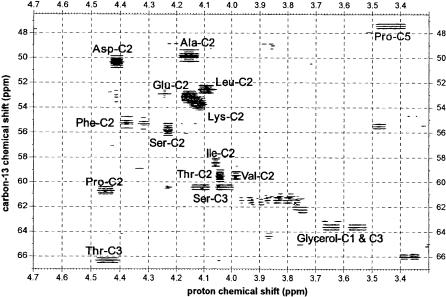
18 |
A.A. de Graaf et al. |
Fig. 6. Detail of a 2D HSQC contour lines spectrum of a protein hydrolysate of Corynebacterium glutamicum showing the Ca-resonances of several amino acids as indicated. Cross-sections along the 13C chemical shift dimension yield multiplets as in Fig. 3b that can be used to determine relative isotopomer abundancies. The cells were incubated with [13C6]glucose against a background of both unlabelled and [1-13C]glucose
in labelling of PEP and pyruvate could be observed. Therefore, in a recent analysis based on isotopomer labelling patterns we employed an optimised mixture of labelled substrates (Fig. 7) in which a co-feeding of [3-13C]lactate was applied in order to induce a differential labelling of the PEP and pyruvate pools. The substrate mixture further contained glucose of which 10% was [13C6]glucose, commonly used in isotopomer analysis [42, 45], applied against a background of 90% primarily unlabelled glucose. Since lactate represented only 8.5% of the total carbon source and the experiments were conducted under C-limiting conditions, i.e. no measurable levels of glucose and lactate were observed, it can be expected that the metabolism was effectively undisturbed as compared to the situation of glucose being the sole carbon source. As can be seen in Fig. 8a and b, the influx of [3-13C]lactate was indeed found to lead to pyruvate with a significantly higher abundance of isotopomers labelled in C-3 but not in C-2 as compared to PEP.
Since Corynebacterium glutamicum does not possess a PEPsynthetase, no [3- 13C]PEP isotopomers can be formed from pyruvate. Thus, any [3-13C]oxaloac- etate isotopomers must result from the action of PyrCx in vivo and their relative abundance allows to quantitate the relative contributions of PEPCx and PyrCx to oxaloacetate synthesis. In the aspartate derived from oxaloacetate a content of isotopomers labelled in C-3 but not in C-2 similarly high as that in pyruvate was found (Fig. 8c), suggesting synthesis of oxaloacetate from pyru-
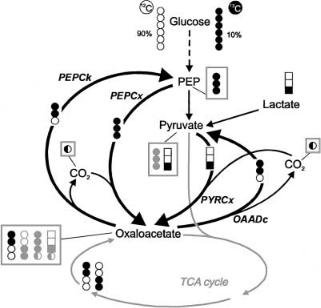
Metabolic Engineering for L-Lysine Production by Corynebacterium glutamicum |
19 |
Fig. 7. Rationale for the detailed quantification of C3-C4 interconversion in C. glutamicum by isotopomer analysis explained in the text. The substrate mixture consists of unlabelled and uniformly labelled glucose, and [3-13C]lactate as a co-substrate. Full circles/boxes represent 13C carbons, empty ones 12C. Isotopomers crucial for enzyme activity identification are in black, abundant secondary ones shaded grey
vate rather than from PEP. This qualitative view was completely confirmed by the ensuing precise mathematical analysis, which showed that 89% of anaplerotic oxaloacetate synthesis is via PyrCx, and only 11% via PEPCx [46]. Thus, in carbon-limited, glucose-grown chemostat cultures of C. glutamicum pyruvate carboxylase is the principal anaplerotic reaction. This contrasts with earlier assumtions that PEPCx was the principal route, but confirms another study that investigated relative use of PEPCx and PyrCx using 13C NMR and GC-MS [47].
While the question of relative use of PEPCx and PyrCx could have been solved from analysis of positional 13C enrichments alone upon co-feeding of [3- 13C]lactate, isotopomer analysis involving more complex measurement and modelling procedures was necessary to differentiate between the various C4decarboxylating enzyme activities present in C. glutamicum. Therefore, the second purpose of the new labelling strategy was to produce a unique isotopomer composition of TCA-cycle–generated oxaloacetate in order to detect its backcycling to PEP and/or pyruvate. The [13C6] glucose applied against a background of unlabeled glucose, if metabolised exclusively via glycolysis, gives rise only to [12C3] and [13C3] isotopomers in PEP and pyruvate. If glucose 6-phos- phate is metabolised over the oxidative pentose phosphate pathway and the transaldolase/transketolase routes, it can be shown that not only the [12C3] and
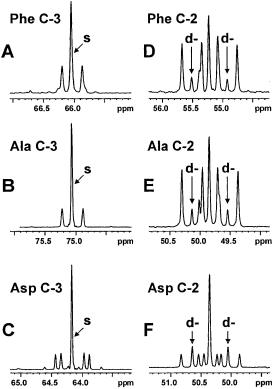
20 |
A.A. de Graaf et al. |
Fig. 8. Experimental 13C NMR spectra of several amino acids from a hydrolysate of C. glutamicum ATCC 13032 incubated with a mixture of 13C-labelled glucose and lactate (see Fig. 7)
(a) the C-3 carbon of phenylalanine (Phe), (b) the C-3 carbon of alanine (Ala), (c) the C-3 carbon of aspartate (Asp), (d) the C-2 carbon of Phe, (e) the C-2 carbon of Ala, (f) the C-2 carbon of Asp. Cf. Fig. 3b. The elevated singlet (s) contribution in Ala C-3 as compared to Phe C- 3 reflects the influx of [3-13C]lactate into the pyruvate pool; the similarly high singlet contribution to Asp C-3 indicates that the main anaplerotic activity is by pyruvate carboxylase and not PEPcarboxylase. The Asp C-2 signals reveal the high abundance of the [1,2-13C2] isotopomer, identified from the d- doublet signals as indicated, resulting from citric acid cycle activity (Fig. 7). The significant presence of this isotopomer in Phe seen from the C-2 d-doub- let signals is evidence of a strong oxaloacetate-decarboxylating flux via PEPcarboxykinase. Since the [1,2-13C2] abundance in Ala is virtually identical to that in Phe, it is concluded that litle or no activity of oxaloacetate decarboxylase and malic enzyme is present in vivo
[13C3] isotopomers, but also the [2,3-13C2] and the [1-13C] isotopomers of PEP and pyruvate will be generated. The important point is, however, that no [1,2- 13C2] PEP or pyruvate will be formed via any of these routes. In contrast, metabolisation via pyruvate dehydrogenase and the citric acid cycle of the most prominent [13C3]pyruvate isotopomer against the background of unlabeled pyruvate leads primarily to [1,2-13C2] and [3,4-13C2] isotopomers of oxaloacetate (Fig. 8f). After decarboxylation by PEPcarboxykinase (PEPCk) or oxaloacetate decarboxylase (OAADc) these give rise to [1,2-13C2]PEP and [3-13C]PEP or
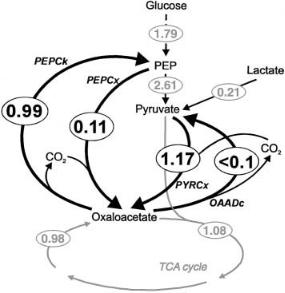
Metabolic Engineering for L-Lysine Production by Corynebacterium glutamicum |
21 |
[1,2-13C2] pyruvate and [3-13C] pyruvate (Fig. 7). Considerable amounts of the [1,2-13C2] isotopomers uniquely reflecting oxaloacetate decarboxylation were found in the experimental spectrum of the C-2 carbon of phenylalanine (Fig. 8d), indicating a strong backflux of oxaloacetate to PEP via the action of PEPCk. The spectrum of carbon 2 of pyruvate-derived alanine (Fig. 8e) showed an abundance of [1,2-13C2] isotopomers almost identical to that in phenylalanine. Therefore, it was concluded that negligible recycling of oxaloacetate (and/or malate) to pyruvate occurred in C. glutamicum under the conditions studied. Thus, despite their high in vitro activities OAADc and malic enzyme appeared to be inactive in vivo. This illustrates the usefulness and added value of the 13C NMR isotopomer analysis.
3.7
Anaplerotic Cycling in Corynebacterium glutamicum
The final flux distribution over the anaplerotic enzymes of C. glutamicum resulting from the isotopomer analysis [46] is shown in Fig. 9. The activity of PEPCk even during growth at a rate of 0.1 h–1 on glucose leads to a futile cycle in which the energy equivalent of approx. 1 mmol ATP per gram dry weight and hour is dissipated. Since the biomass synthesis at this growth rate may require around 3.5 mmol ATP per gram dry weight and hour [48] it is to be expected that this substrate cycling adds significantly to the maintenance energy requirement of C. glutamicum. Furthermore, the fact that the PEPCk reaction
Fig. 9. Finally determined detailed flux distribution in the anaplerosis of C. glutamicum ATCC 13032. Data from [46]
22 |
A.A. de Graaf et al. |
withdraws aspartate which is essential for lysine biosynthesis may limit lysine yields. Therefore, construction of a C. glutamicum strain with strongly reduced anaplerotic cycling activity by deleting the gene for PEPCk is an important target for metabolic engineering of C. glutamicum towards increased growth efficiency and improved lysine yields.
4
L-Lysine synthesis
4.1
Control by Aspartate Kinase and Lysine Exporter
As mentioned, the biosynthesis of lysine from oxaloacetate and pyruvate in C. glutamicum occurs via a split pathway [38] (Fig. 10). Clearly, a split pathway is untypical for a biosynthesis pathway. It has been demonstrated that in addition to L-lysine formation this pathway structure ensures the reliable provision of the cell with the intermediate D,L-diaminopimelate, which is an important linking unit within the peptidoglycan layer [49]. One step of flux control through the pathway is at the level of the aspartate kinase. As is typical of an enzyme at the start of a lengthy synthesis pathway, the kinase is controlled in its catalytic activity. The enzyme activity is allosterically inhibited when L-lysine plus L- threonine together are present in excess. Due to its importance in flux control in one line of producers this feed back control is removed by mutations in the b-subunit of the kinase [50]. Also a strain with two copies of the kinase genes was made and shown to result in increased L-lysine accumulation [51]. In another line of stains the kinase is relieved of allosteric inhibition due to low homoserine dehydrogenase activity resulting in a low L-threonine concentration which no longer inhibits the kinase activity [2].
A further flux control for L-lysine production is at the level of export. A specific export carrier is present [52], whose expression is regulated by an autogeneously controlled transcriptional regulator[53]. This hitherto unknown type of control by export, serves to regulate the intracellular L-lysine or L-arginine concentration under special conditions, where high, non cellular-made concentrations of these amino acids are present. This is for instance the case when C. glutamicum is exposed in its natural habitat to L-lysine-containing peptides. Since the organism has no L-lysine-degrading activities any excess of L-lysine must be exported. Thus, only the presence of this “valve” has enabled that mutations overcoming flux control within the biosynthesis pathway have indeed resulted in cellular L-lysine formation from glucose. The L-lysine exporter has now been recognized to represent a large new superfamily of translocators with members present in many bacteria including archeae [54]. Probably all are involved in export of small solutes from the cell [55]. One subfamily of the LysE superfamily is RhtB, which contains exporters of E. coli related with L-threonine and L-homoserine export [56].
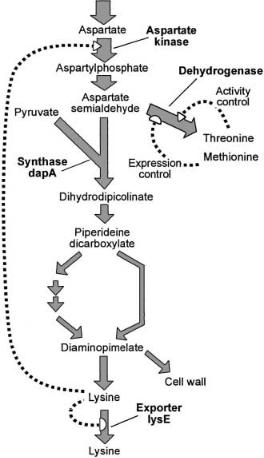
Metabolic Engineering for L-Lysine Production by Corynebacterium glutamicum |
23 |
Fig. 10. Schematic representation of the split biosynthetic pathway of L-lysine in wildtype Corynebacterium glutamicum including the branch point of aspartate semialdehyde distribution. The metabolites derived from the aldehyde via the synthase activity are D,L-di- aminopimelate and L-lysine, whereas that resulting from dehydrogenase activity are L-threo- nine, L-methionine, and L-isoleucine. The activity of the dehydrogenase is inhibited at elevated L-threonine concentrations and its synthesis is repressed by L-methionine. Accumulating intracellular lysine causes feedback inhibition of aspartate kinase and activates lysE transcription
4.2
Control by Dihydrodipicolinate Synthase Activity
A further flux control step within L-lysine synthesis is the aspartate semialdehyde branch point. The aldehyde is either used as a substrate for the homoserine dehydrogenase, or together with pyruvate as a substrate for the dihydrodipicolinate synthase (Fig. 10). Whereas the homoserine dehydrogenase is allosterically controlled in its catalytic activity by the L-threonine concentration

24 |
A.A. de Graaf et al. |
and repressed by L-methionine [57], no such control is known for the dihydrodipicolinate synthase [58]. Overexpression of the dihydrodipicolinate synthase gene dapA resulted in increased L-lysine accumulation [59]. At first sight this could be interpreted as the “opening of a bottleneck”. However, as will be outlined subsequently, dapA overexpression effects the flux at the entire aspartate semialdehyde branch point.
As can be seen in Table 2, the wild type with one dapA-copy does not excrete L-lysine, which is due to tight regulation of flux at aspartate kinase and dihydrodipicolinate synthase. However, already introduction of a second copy results in increased L-lysine synthesis and its excretion. This is due to an elevated intracellular L-lysine concentration and the triggering of the export machinery. A further increase in the copy number increases the dihydrodipicolinate synthase activity and L-lysine excretion as well [60]. This is due to two effects. The first are the kinetic properties of the competing enzymes at the branch point. Thus the dihydrodipicolinate synthase has a low affinity for the aldehyde
(Km = 2.08 mM) and a low maximal specific activity (vmax = 0.09 µmol min–1 (mg protein)–1, whereas the corresponding values for the homoserine dehydroge-
nase are nearly one order of magnitude higher (Km = 0.37 mM; vmax = 0.75 µmol min–1 (mg protein)–1. These data, as well as the concentration of the aspartate semialdehyde in the cell of about 0.05 mM, show that the flux towards L-lysine is determined by the low affinity of the dihydrodipicolinate synthase. Since this flux control could not be operative when the homoserine dehydrogenase would have low affinity and activity, in fact both the homoserine dehydrogenase and the dihydrodipicolinate synthase together are elements of flux control for aspartate semialdehyde distribution.
The second effect resulting in increased flux towards L-lysine as a consequence of dapA overexpression is more subtle. As can be seen in Table 2, gradual dapA overexpression results also in a gradual reduction of the growth rate. Therefore, cell growth is limited.As the quantification of the intracellular amino acid concentrations revealed (Table 2) it is the L-threonine concentration which is reduced upon dapA overexpression. This unexpected finding is confirmed by the fact that addition of L-homoserine, for instance, restores growth of a dapA overexpressing strain [60]. Why an expected release of feedback inhibition of
Table 2. The overexpression of dapA effects the cellular flux towards L-threonine and L-lysine, as well as the growth rate
C. glutamicum |
dapA |
Synthase |
Growth |
Intra- |
Intra- |
Lysine |
Strain |
copies |
activity |
rate |
cellular |
cellular |
excretion |
|
|
(U mg |
(h–1) |
Threonine |
Valine |
rate (nmol |
|
|
protein–1) |
|
(mmol–1) |
(mmol–1) |
min–1 mg |
|
|
|
|
|
|
dry wt–1) |
|
|
|
|
|
|
|
13032 |
1 |
0.05 |
0.43 |
9 |
3 |
0.0 |
13032::dapA |
2 |
0.082 |
0.37 |
3 |
6 |
0.2 |
13032 pKW3::dapA |
6 |
0.25 |
0.36 |
≈ 1 |
8 |
2.7 |
13032 pJC24 |
20 |
0.63 |
0.22 |
≈ 1 |
10 |
3.8 |
|
|
|
|
|
|
|
Metabolic Engineering for L-Lysine Production by Corynebacterium glutamicum |
25 |
the homoserine dehydrogenase by L-threonine (Fig. 10) does not compensate for the limitation is not yet understood, but subject to current analysis. However, most importantly, the growth limitation results in an increased availability of intracellular precursors, as for example pyruvate. This is evident from the increased concentration of L-valine (Table 2), which is synthesized from two pyruvate molecules. An additional advantage of increased L-lysine synthesis due to dapA overexpression is the reduced extracellular accumulation of some minor byproducts formed [61]. This is the case when dapA is overexpressed in the background of a high-level producer strain, like MH20–22B. In this strain, plasmid-encoded dapA overexpression results in an increased L-lysine accumulation from about 230 mM to 280 mM, accompanied by a reduction of L- isoleucine and L-alanine from concentrations of 6 mM to concentrations below 1 mM. It should be mentioned that in many amino acid-fermentation processes growth limitations by limiting medium components (e.g. phosphate) are used to achieve increased product formation [62, 63]. Limiting intracellular fluxes by genetic engineering has the advantage to stabilize fermentations by making them independent of variations of limiting medium components.
4.3
Flux Increase by Engineering dapA Expression
Due to the importance of the total dihydrodipicolinate synthase activity in high-level producer strains, dapA transcription was investigated in detail. This served to finally adjust optimal expression of this gene. This is a particular interesting example of strain engineering to ultimately result in a plasmid-free, self-cloned strain carrying only C. glutamicum sequences. C. glutamicum promotors are characterized by a –10 region consisting of the consensus sequence TANAAT which is comparable to that of E. coli, Bacillus, Lactococcus or Streptococcus [64]. However, in C. glutamicum a –35 region is much less conserved. As a first step to engineer the dapA promoter, the specific dapA transcript initiation site within the dapB-orf2-dapA-orf4 operon was identified [65]. According to the structure of the synthase protein [66] it has to be concluded that the transcript initiation site is identical or very close to the translation initiation site. This is one of the several examples in C. glutamicum where such a situation exists, and is the case, for instance, with ilvA, lpd, thrC, or the ilvB-leader. How translation without classical ribosome binding site occurs is unknown. Probably secondary structures around the transcript initiation site are involved as well as additional protein components, like the orf4-encoded polypeptide of the operon. As a second step a deletion analysis of the dapA promotor was made, with dapA fused to the chloramphenicol acetyl transferase (CAT) gene serving as a reporter [67]. This enabled to confine the essential elements for transcript initiation to an 80 bp fragment (–86 to –7) carrying an essential stretch of T’s at position –57 to –52 and of course the essential –10 region.
The further engineering of the promoter and the generation of the respective strain without any vector sequences is outlined in Fig. 11. Based on known sequences of strong promotors of C. glutamicum directed mutations were introduced, which among others resulted in promotor MC 20 with nearly four-fold
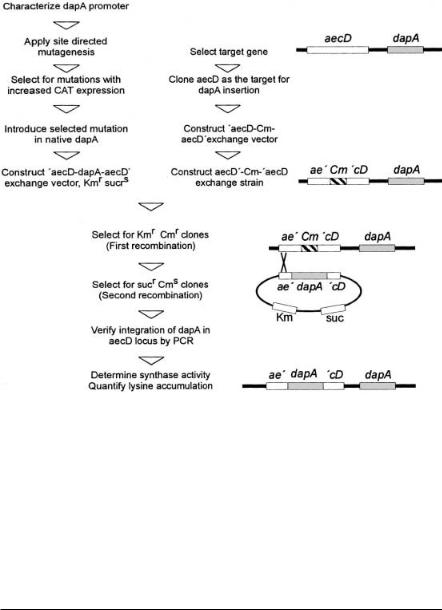
26 |
A.A. de Graaf et al. |
Fig. 11. Flow scheme of the different steps to generate a vectorless L-lysine producer from C. glutamicum with increased dihydrodipicolinate synthase activity. This procedure makes extensive use of homologuous recombinations and several positive selection procedures [16]. In the upper left the steps needed to make a dapA promoter resulting in high chloramphenicol acetyl transferase activity as well as to generate an exchange vector carrying dapA with the mutated promoter and flanking aecD regions [68] are given. The middle part of the flow scheme shows the steps to make a strain which has aecD interrupted by a Cmr gene. In the lower part the steps to select for an exchange of the chromosomal Cmr gene by the mutated dapA are illustrated. The proper strain construction is verified by PCR, enzyme measurements and product accumulation. The chromosomal situation of the respective strain is given on the right
Table 3. Effect of dapA promotor mutations on dihydrodipicolinate synthase activity and L-lysine accumulation after 48 h of cultivation
Strain |
Promotor sequence |
dapA |
Synthase activity |
L-Lysine |
|
–31………………………–9 |
copies |
(U/mg) |
(g/L) |
|
|
|
|
|
MH20–22B |
|
1 |
0.046 |
13.46 |
MH20–22B |
CAAATG……AGGTAACCT |
2 |
0.105 |
15.98 |
Mutant MA 16 CAAAATG……AGGTATAAT |
2 |
0.137 |
16.62 |
|
Mutant MC 20 |
CAAATG……TGGTAACCT |
2 |
0.185 |
17.27 |
|
|
|
|
|
Metabolic Engineering for L-Lysine Production by Corynebacterium glutamicum |
27 |
increased transcription initiation. In the specific MC 20 promotor,A in position
–17 is replaced by T (Table 3). Then several steps were necessary to transfer a second copy of dapA with the point mutation in its promotor in the chromosome of the L-lysine producer. As the final result, L-lysine producers were obtained with C. glutamicum sequences only, which exhibit increased synthase activity. As can be seen from Table 3, the selected strains have a substantially increased L-lysine accumulation.
5 Conclusion
The purposeful metabolic engineering of Corynebacterium glutamicum for improved amino acid production was shown to benefit from the integrated application of methods for biochemical analysis, genetic engineering, mathematical modelling and metabolic flux analysis. Chromosomal genetic engineering of the dapA resulted in a stable overexpression of dihydrodipicolinate synthase and a significantly increased lysine production as a consequence of redistribution of the fluxes at the aspartate semialdehyde branchpoint in the l-lysine biosynthetic pathway. Detailed analysis of the anaplerotic enzyme activities in vivo by refined 13C isotopomer labelling techniques resulted in the identification of phosphoenolpyruvate carboxykinase as the enzyme responsible for strong futile cycling in the anaplerotic network of C. glutamicum which was previously shown to correlate with a decreased lysine production. In the near future, it is expected that integrated monitoring and modelling of the effects of genetic changes on the proteome, the metabolome and the fluxome level will provide a significantly improved insight in the regulatory processes involved in amino acid overproduction by Corynebacterium glutamicum.
Acknowledgement. We thank Degussa and the BMBF for continuous support of the work on C. glutamicum.
References
1.Kinoshita S, Udaka S, Shimono M (1957) J Gen Appl Microbiol 3:193
2.Aida K, Chibata I, Nakayama K, Yamada H (1986) Biotechnology of amino acid production. In: Progress in biotechnology, vol 21. Elsevier
3.Eggeling L, Sahm H (1999) Appl Microbiol Biotechnol 52:146
4.Leuchtenberger W (1996) In: Rehm HJ, Reed G (ed) Biotechnology, vol 6, VCH Verlagsgesellschaft, Weinheim, p 455
5.Eggeling L, Morbach S, Sahm H (1997) J Biotechnol 56:167
6.Eggeling L, de Graaf A, Sahm H (1996) Adv Biochem Eng 54:1
7.Eggeling L, Sahm H (1999) In: Lee SY, Papoutsakis ET (ed) Metabolic Engineering, Marcel Dekker, Inc, New York Basel, p 153
8.Jakoby M, Nolden L, Meier-Wagner J, Krämer R, Burkovski A (2000) Mol Microbiol 37:964
9.Peters-Wendisch P, Kreutzer C, Kalinowski J, Patek M, Sahm H, Eikmanns BJ (1998) Microbiology 144:915
10.Schäfer A, Tauch A, Jäger W, Kalinowski J, Thierbach G, Pühler A (1994) Gene 145:69
11.Ankri S, Serebrijski I, Reyes O, Leblon, G (1996) J Bacteriol 178:4412
12.Marx A, de Graaf AA, Wiechert W, Eggeling L, Sahm H (1996) Biotechnol Bioeng 49:111
